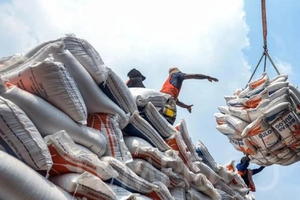 Illustrative photo
Illustrative photo
While the trend of developing green energy in the world has gathered momentum, there is still no breakthrough solution in offshore wind power energy in Vietnam. This resource needs to be tapped and developed for future growth and as an alternative for other fast diminishing natural resources.
Renewable energy resource
Fossil fuel resources such as coal, oil and gas will be available for only a few more decades, and humanity will then be in danger of a serious shortage of this energy resource. Therefore, many countries around the world have taken advantage of and further developed wind power energy, which is an inexhaustible and abundant available resource. According to an assessment by the International Energy Agency (IEA), global wind power resources have the potential to reach 420,000 TWh annually, which is eighteen times more than the current world demand.
In 1991, the world's first offshore wind power project was built in Vindeby in Denmark. It had eleven turbines and a capacity of 450 kW of five MW at a depth of four meters near the shore. After the life cycle of the offshore wind power project completed about 25 years, it was dismantled in 2017.
More recently, offshore wind projects have reached several GW of capacity, with turbines as large as 12 MW and at depths of nearly 200 meters and more than 100 kilometers offshore. Before 2016, the investment cost of 1 MWh of wind power was up to US$ 200 per 1 MWh. Recently with the introduction of new technology, the price has dropped sharply to US$ 50 to US$ 100 per 1 MWh.
The offshore wind power market is growing continuously every year at the rate of about 30%. Currently, there are about 150 large marine wind farms in operation, sharply increasing in 2018 in the UK, Germany, Denmark, the US, and China. Europe has also installed 20 GW of offshore wind power and has a supportive policy to quadruple it to 80 GW by 2030. IEA forecasts that by 2040, offshore wind power globally will have a development investment of about US$ 1,000 bln, with an annual growth rate of 13 percent of installed capacity.
Currently, Vietnam's total power plants of 40 GW are in operation with the main sources being hydroelectricity and coal-fired power which are basically now being exhausted. According to the World Bank (WB), there is potential for 475 GW of offshore wind power in the sea with a depth of less than 200 meters.
Therefore, with potential of offshore wind power many times the existing capacity, it is possible to meet current and future electricity demands. The coastal area, especially the Southern region, has an area of about 142,000 square kilometers with a depth of 60 meters, which has very good potential for wind power development. The survey data shows that the wind speed in this area at an altitude of 100 meters reaches 7 to 10 m/s.
Currently, the Bac Lieu wind farm at sea with a capacity of 100 MW has been operating and providing about 300 million kWh per year, and by 2025 will increase up to 1,000 MW or 3 billion kWh per year. In general, the wind turbine farms in Bac Lieu have operated well, bringing high economic efficiency and the opportunity to recover capital is just about ten years.
The turbine life is of 50 years, contributing to the local budget at VND 76 billion per year. The Thang Long super project off the coast of Binh Thuan has a capacity of 3.4 GW and is in the process of acquiring a feasibility study. If this project is completed before 2030, it will bring effective offshore wind power to Vietnam.
Legal framework
The draft Power Plan-VIII of the Ministry of Industry and Trade offers a capacity of 16 GW of onshore and nearshore wind power, with 7 GW of offshore wind power by 2030 and by 2045 there will be 122 GW of total wind power capacity. This offshore wind power will be 66 GW. These are quite challenging and ambitious goals because in order to achieve them it is necessary to have timely marine spatial planning and an environmental legal framework.
From now until 2030, there are only eight years remaining. Offshore wind power projects need at least seven to ten years to complete the stages of survey, wind measurement, geological research, feasibility assessment, environmental impact assessment, design, manufacture of components, construction, and final installation. Implementation of offshore wind power projects is technically complex and requires huge financial investment. Therefore, it is necessary to start immediately, from the granting of geological survey permits to a clear and long-term policy mechanism.
It is estimated that by 2050 Vietnam can use offshore wind power resources to meet nearly 30% of electricity demand in the country, and possibly even higher, depending on the market as well as technological progress. However, offshore wind power needs long-term planning and a clear and stable policy framework, which is also a necessary condition to attract investments as the cost of such projects is not cheap. For instance, offshore wind measurement alone will cost a huge financial amount of about USD$2 million. This does not include the cost for other administrative procedures and surveys which may bring the total to about US$ 15 million per project.
To achieve this, it will be necessary to have effective national policies for offshore wind power projects, such as the early formulation of a national strategy for offshore wind power development. It will also require a marine spatial plan for offshore wind power development in association with the National Strategy on marine wind energy development upto 2030, with a vision until 2045.
In addition, it is necessary to develop, supplement, and complete the national institutional and policy framework on licensing, appraisal, environmental impact assessment, marine leasing, development of offshore wind power projects, and other marine energy projects.
























